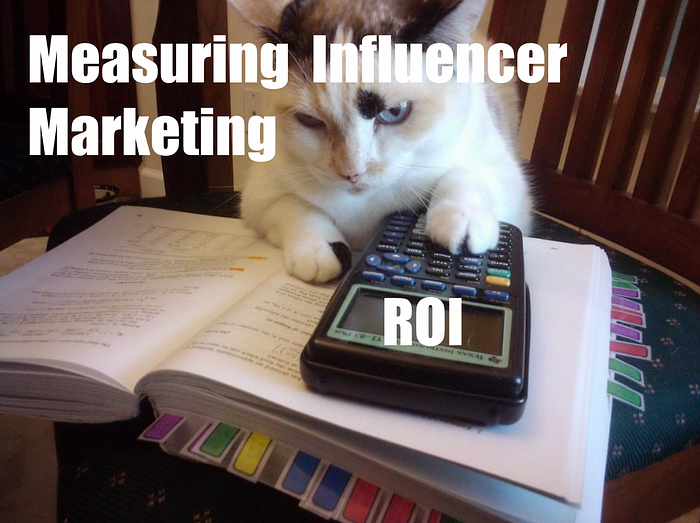
Most marketers and small business owners still decide which Instagram Influencers to partner with and pay based on who they think is “cool”, or even worse, whoever their bosses’ or friend’s daughters/sons think is “cool”. This is a mistake. You run a business and you should pay influencers who give you the highest return for your dollar, regardless of whether you think they are “cool” or not. Good news is, it’s easy to measure your Influencer Marketing ROI if you know which metrics to pay attention to and how to measure them.
The Essentials.
Before we delve into the metrics, it’s important that you first take care of a couple of things. To properly calculate your ROI, you’ll need:
- An Instagram Business account. Without one, you won’t have access to your Instagram Insights data and won’t be able to measure your ROI properly.
- The Dollar Amount Spent Generating The Influencer’s Promotion. In other words, you should know the cost of either paying for an influencer to promote you or the costs of gifting the influencer to promote you (or both). By knowing the dollar amount, you’ll be able to compare the return on your Influencer Marketing activities to all other Marketing activities you embark in, and know which is more effective.
Once you have those two elements, you get your Influencer Marketing ROI by measuring the performance of each influencer campaign through 4 metrics:
Profile Visits Per Dollar
What it tells you: How many of an influencer’s followers saw the promotion and found it relevant enough to tap on your username.
Why it matters: This metric tells you how many of an influencer’s followers trust that influencer enough to tap on the username of the brand/company/service/Instagram account that is recommended in the post, without knowing anything else about the brand/company/service/Instagram account itself. This is important because you want to partner with the influencers who are trusted by their audience, and you can’t know who is trusted and who is not unless you measure the Profile Visits Per Dollar.
How to measure it: This one is the hardest metrics to measure effectively because Instagram only gives you weekly (not daily) profile visits data through your Instagram Insights. Knowing that limitation, you will get a decent measurement of the Profile Visits Per Dollar by first calculating Profile Visits Received From The Influencer’s Promotion (by subtracting the number of “profile visits in the last 7 days” 7 days after the influencer’s promotion by the number of “profile visits in the last 7 days” the day of the influencer’s promotion) and diving that number by the Dollar Amount Spent Generating The Influencer’s Promotion.
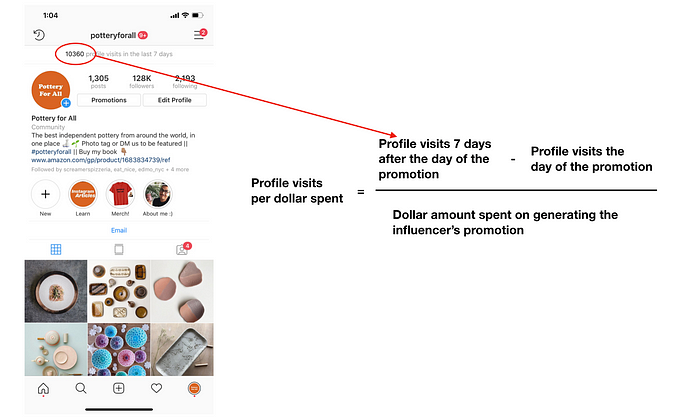
The higher this number is, the more effective the promotion was.
How to maximize results on this metric: When looking to maximize the number of Profile Visits Per Dollar spent on an Influencer, I’d recommend that you aim to partner with influencer with over 10K followers and over 15% engagement. Engagement is the main measurable indicator of trust, so the higher the engagement of an influencer, the larger the percentage of their audience that trusts and values their recommendations and the higher the number of profile visits per follower the influencer is likely to drive per post.
New Followers Per Dollar
What it tells you: How many of the influencer’s followers found your Instagram account valuable enough to follow.
Why it matters: If you’re doing influencer marketing on Instagram, more likely than not, people will first discover your brand and make up their mind about it solely based on how your account looks and feels. If you are generating a large number of Profile Visits Per Dollar, but a very small number of Followers Per Dollar, your account is likely not communicating enough value to the new audience that’s discovering your account or you’re marketing to the wrong audience (both bad things). You want to have an Instagram account that converts the highest percentage possible of profile visits, but you won’t know what your conversion is like unless you measure your Followers Per Dollar Spent.
How to measure it: To measure the New Followers Per Dollar, you first need to calculate your:
- Average Number Of New Daily Followers: You calculate it by dividing the new followers gained in the past week (you find that through the Audience tab in your Instagram Insights) by 7.

- New Followers From Promotion: This is the total number of new followers gained in the three days after the influencer promoted you (you’ll get 90% of the new followers gained in the lifetime of the promotion within 3 days of it going live). Since Instagram Insights doesn’t give you daily follower numbers, you can find that number by using a third party tool like Social Blade and just adding the total followers gained in the three days after the influencer promoted. Once you have that number, you subtract from it the Average Number Of New Daily Followers you already calculated, multiplied by three.
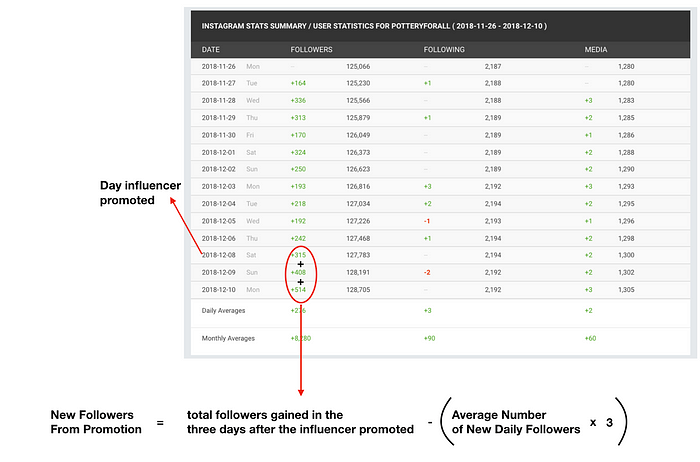
Now, divide the New Followers From Promotion by the Dollar Amount Spent Generating The Influencer’s Promotion and you’ll find your New Followers Per Dollar.

The higher this number is, the more effective your Instagram account is at converting profile visits into followers.
How to maximize results on this metric: The most effective way to maximize your New Followers Per Dollar is to first have an Instagram account with high-value content and a highly differentiated grid that properly shows off that content. The second way is to make sure that you’re partnering with influencers who’s audience is likely to find value in your content. There’s no science to that, but you can get a rough idea by making sure that your product/brand/Instagram is an organic fit into the influencer’s life (i.e. Would the influencer actually use your product in real life or are they only promoting it for the money?).
Website Traffic Per Dollar
What it tells you: How many of the influencer’s followers took enough interest in the promotion to view your website.
Why it matters: More likely than not, you won’t earn any money from your influencer’s promotion unless people reach your website, and you don't know how many people reached that point unless you measure that. Once you measure traffic driven from several influencer campaigns, you will be able to objectively know which posts were better at driving people to your site. This will give you insights into what makes some posts more effective than others and you’ll be able to incorporate that into future campaigns.
How to measure it: To measure the Website Traffic Per Dollar Spent, you first need to calculate your:
- Average Daily Website Sessions: You calculate that by finding the total number of websites sessions in the past week (you can usually find that in the analytics section of any e-commerce or website provider. I’m using my Shopify as an example) and dividing that by 7.
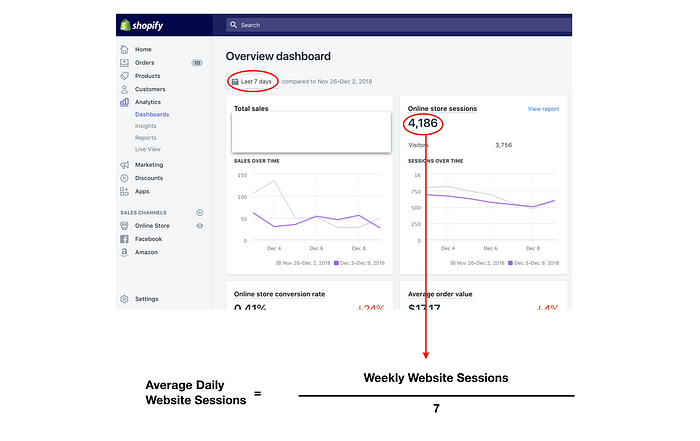
- New Website Sessions From Promotion: This is the total number of new website sessions in the three days after the influencer promoted you (you’ll get 90% of the new website traffic in the lifetime of the promotion within 3 days of it going live). You can find that by filtering your website analytics to the three days after the promo and noting how many store visits total you received for those days. From that number, you subtract your Average Daily Website Sessions multiplied by three and you get the New Website Sessions From Promotion.
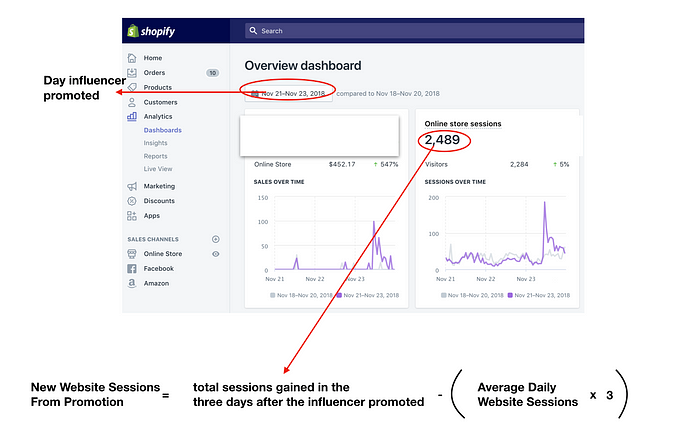
Once you’ve found your New Website Sessions From Promotion, you just divide that number by the Dollar Amount Spent Generating The Influencer’s Promotion and you’ll find your Website Traffic Per Dollar.

The higher this number is, the more effective your influencer partnership was at driving people to your website.
How to maximize results on this metric: A tweak that will help you here is to always make sure your link in bio leads to your website. Instagram doesn’t allow tappable links in posts so, apart from that, there’s little you can do here except giving the influencer the best working experience possible and the right incentives (money and/or value) so they are invested in doing a promo that performs well.
Sales (or downloads, or newsletter signups, etc) per dollar
What it tells you: How many of the influencer’s followers found your product valuable/important enough to buy it.
Why it matters: If you’re running a business, you want to get the highest possible return from the time and money you invest in your Influencer Marketing. You won’t know what that return is unless you measure the sales (or downloads, or newsletter signups, etc) you get from each partnership.
How to measure it: This one depends on what metric you’re trying to measure (sales, downloads, newsletter subscribers, attendees, etc) but for the purpose of this article, we’ll focus on sales. Like Website Traffic Per Dollar Spent, to measure Sales Per Dollar you first need to calculate your:
- Average Daily Sales: You calculate that by finding the total number of Sales in the past week (you can usually find that in the analytics section of any e-commerce or website provider. I’m using my Shopify as an example) and dividing that by 7.
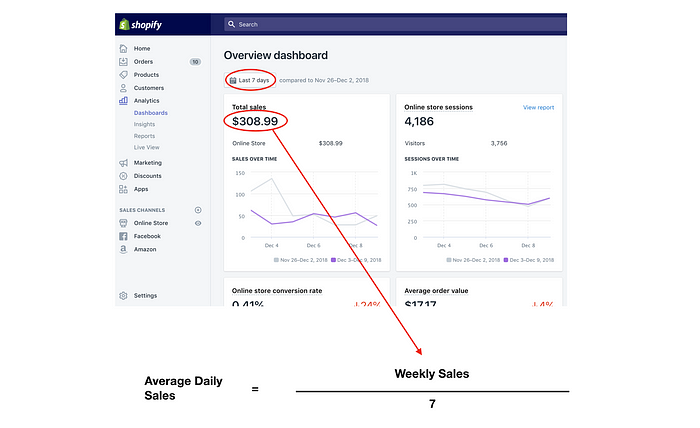
- New Sales From Promotion: This is the total number of new sales in the three days after the influencer promoted you (you’ll get 90% of the new sales in the lifetime of the promotion within 3 days of it going live). You can find that by filtering your website analytics to the three days after the promo and noting how many sales you received for those days. From that number, you subtract your Average Daily Sales multiplied by three and you get the New Sales From Promotion.
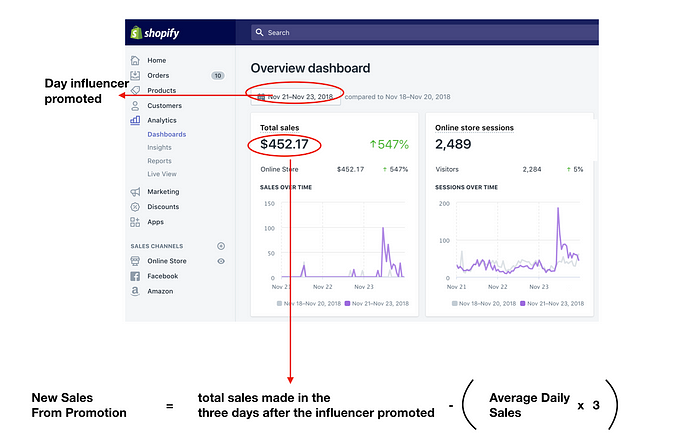
The higher this number is, the more effective your influencer partnership was at driving sales.
How to maximize results on this metric: There’s no one way to maximize sales (if there was, we’d all be rich), but when it comes to influencer marketing specifically, 3 elements tend to matter most. First, “like” engagement. The higher the engagement the influencer has, the higher the likelihood that their audience cares about them enough to spend their money in what they promote, so you want to partner with only influencers with the highest engagement (I wouldn’t recommend settling for influencers who have less than 15% engagement). Second, price. People on Instagram are still hesitant to spend on high ticket items, so having a “low-priced” option when people reach your site will give you a higher likelihood of selling after the partnership. And third, making sure that you are the first (or one of the first) products the influencer is promoting within your category. For example, if an influencer has promoted 100 different sweaters before yours, you are likely to get MUCH lower sales in comparison to being the 1st sweater that influencer promotes.
Use your ROI data!
Once you’ve executed a few campaigns with a few influencers, you can use these ROI metrics to compare results and evaluate which influencers gave you the highest return.

Not only that, but you can also start comparing your influencer marketing spend to your spend on other Marketing activities. For example, you might be generating .25 sales per dollar spent on Influencer Marketing vs. .15 sales per dollar spend on Instagram Advertising. Which should you spend more money on? This sort of insights aren't intuitive unless you’re measuring the returns on all of your Marketing campaigns, especially Influencer Marketing, which people usually are less rigorous about.
AANDDD, that’s it! That’s how you measure the ROI on your Instagram Influencer Marketing campaigns. Now that you know how to do it, there’s no excuse not to ;)
Hope they help!

By the way, if you want to dive deeper into other strategies and systems to grow your Instagram faster, read these articles on how to grow your Instagram without buying followers. Then, you can tackle the following: how the Instagram algorithm works, how to make money on Instagram, the best Instagram bots, why your Instagram account isn’t growing, how to create effective Instagram story ads, how to create a visually appealing Instagram grid, how to increase your Instagram engagement, how to find the most valuable Instagram influencers, how to measure what an influencer is worth, how to measure your influencer marketing ROI, and how to reach out to influencers.
